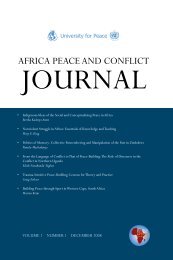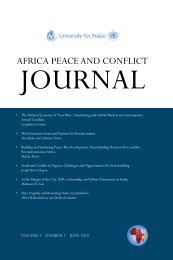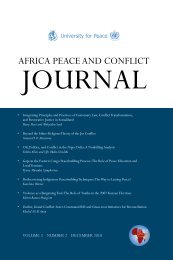Download - Africa Peace and Conflict Journal - The University for ...
Download - Africa Peace and Conflict Journal - The University for ...
Download - Africa Peace and Conflict Journal - The University for ...
You also want an ePaper? Increase the reach of your titles
YUMPU automatically turns print PDFs into web optimized ePapers that Google loves.
Gacaca Courts in Rw<strong>and</strong>a 19THE GACACA SYSTEMGacaca, a Kinyarw<strong>and</strong>a concept, literally means ‘justice on the grass’. Gacaca courts asan endogenous Rw<strong>and</strong>ese dispute resolution system involves people sitting outside,on the grass, to settle their disputes in the presence of community members. LeahWerchick notes that in its precolonial <strong>for</strong>m, gacaca was used to moderate disputesconcerning l<strong>and</strong> use rights, cattle ownership, marriage, inheritance rights, <strong>and</strong> pettytheft, among other interpersonal disagreements. 6 <strong>The</strong> gacaca system did not deal withterribly complicated issues, such as mass murder.<strong>The</strong> gacaca system rests upon the voluntary confession, demonstration of remorse,apology, <strong>and</strong> request <strong>for</strong> <strong>for</strong>giveness by perpetrators. Traditionally, gacaca emphasisedmorality as the basis <strong>for</strong> adjudication. As a result, gacaca courts were run by members ofthe community known as the inyangamugayo, or ‘persons of exemplary conduct’, whowere renowned <strong>for</strong> courage, honor, justice <strong>and</strong> truth. 7 <strong>The</strong> inyangamugayo, deemed to beabove reproach, were given this role based on their high moral <strong>and</strong> ethical st<strong>and</strong>ards. Intraditional Rw<strong>and</strong>a, when a dispute had been resolved, a ritual or ceremony would beheld to reflect the symbolic <strong>and</strong> practical importance of the process. Gacaca sessionsoften ended with the parties sharing a traditional libation <strong>and</strong> a meal as a gesture of reconciliation.Serious offences would result in the offender being ostracized from the community.<strong>The</strong> gacaca system as a typical endogenous method of conflict resolutionresembles similar processes that developed in other parts of <strong>Africa</strong>, including mato oputin northern Ug<strong>and</strong>a, 8 the gadaa system among the Oromo of Ethiopia, 9 <strong>and</strong> the guuirtof Somalil<strong>and</strong>. 10 Gacaca is a distinctly traditional Rw<strong>and</strong>an practice, although it has beeninstrumentalized <strong>and</strong> infused with some European-based ideas about justice. 11<strong>The</strong> Gacaca ProcessIn contemporary Rw<strong>and</strong>a, gacaca processes involve local residents giving testimony<strong>for</strong> <strong>and</strong> against suspects, who are essentially tried in the communities where they areaccused of having committed crimes. <strong>The</strong> majority of individuals tried in gacacacourts are typically prisoners prepared to confess to the atrocities they may have committed<strong>and</strong> freely willing to engage in community adjudication. According to Anne6. L. Werchick, ‘Prospects <strong>for</strong> justice in Rw<strong>and</strong>a’s citizen tribunals’, Human Rights Brief, 8:3 (2001),www.wcl.american.edu/hrbrief/08/3rw<strong>and</strong>a.cfm.7. <strong>The</strong> term inyangamugayo is a Kinyarw<strong>and</strong>a word that translates literally as ‘people who hate evil’.<strong>The</strong>se are persons of integrity who are known to be uncorrupted.8. Mato oput is a reconciliation ceremony conducted among the Acholi of northern Ug<strong>and</strong>a. <strong>The</strong> resolutionof the conflict is symbolized by the conflicting parties drinking a bitter herb mixture from the oputtree from the same vessel.9. <strong>The</strong> gadaa is a system of age-grade classes that succeed each other in assuming political <strong>and</strong> socialresponsibilities. A complete gadaa cycle consists of five age grades. <strong>The</strong> authority held by elders is derivedfrom their position in the gadaa system. For details, see Gumii Bilisummaa Oromiyaa, ‘Underst<strong>and</strong>ing thegadaa system’, 2000, www.gumii.org/gada/understd.html.10. <strong>The</strong> guuirt is the highest-level council of elders in Somalil<strong>and</strong> <strong>and</strong> the highest traditional authority.Each council consists of a body of elders who represent the lineages in the clan <strong>and</strong> is headed by clanleaders, or sultans.11. See M. Sabera et al., ‘<strong>The</strong> gacaca justice system: A process <strong>for</strong> reconciliation <strong>and</strong> sustainable peace’,Women’s World (Kampala), 2007.






